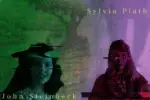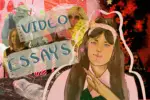When it comes to the realistic illustrations from Japanese graphic designer Shusaku Takaoka, it’s hard to know where to start, not only because of the thousands of pieces he’s posted on his Instagram, but how he takes mixed-media art to a whole new level.
Takaoka has an uncanny ability to juxtapose images from pop culture with antiquity to create pieces that appeal to almost every generation, artistic taste and social issue. He satirizes and re-invents culture, fashion, art and consumerism, many times packing a pure shock value that stops the viewer short and forces them to reevaluate its meaning. Oftentimes, his work sends a poignant message about social issues, while others are simply a fun coalescence of past and present.
For instance, in one series of works, Takaoka responded to the criticism that several Disney princesses had received from actresses like Kristen Bell and Kierra Knightly, who, in light of the #MeToo movement, had questioned the life choices and docile natures of the animated royalty. To do so, Takaoka created mash-ups that pay tribute to the princesses by using cinema’s tendency toward extreme violence.
https://www.instagram.com/p/BrMNEyohGXV/
Bell told “The Today Show” that she makes sure her daughter realizes how wrong it is for someone to kiss someone else while they’re sleeping, specifically referencing Snow White. “I’m a mom who wants my girls to possess critical thinking and ask a ton of questions,” she tweeted after a storm of disparagement for her beef with the beloved classic.
Knightly, on the other hand, bars her daughter from watching some Disney classics. “Cinderella, banned because she waits around for a rich guy to rescue her,” she told Ellen DeGeneres. “Don’t. Rescue yourself, obviously … I really like the film, but ‘Little Mermaid.’ The songs are great, but do not give your voice up for a man.”
Takaoka took it upon himself to depict these characters with swords, guns and high kicks, as if in vehement protest of the predicament their creators put them in. Snow White is portrayed decapitating her prince with a samurai sword in homage to “Kill Bill,” while another has her shooting his head off with gun as he’s about to kiss her as she sleeps. Ariel does the same to Eric, only armed with two, short-barreled shotguns — staunchly disapproving of any advancement on her person, written for her or not.
https://www.instagram.com/p/BnSkcNyH9z4/
Cinderella is shown seated beside Prince Charming in a carriage, handcuffed to the door with a smile. Another piece shows her high-kicking Prince Charming’s head clean off and even shooting herself in the head before trying on the glass slipper, as if out of sheer agony of having little say in anything.
Dialing down the violence, Takaoka loves portraying feminine characters like Pocahontas, Sleeping Beauty, Snow White and others flipping-off their admirers or anyone who comes close. Perhaps Bell and Knightly wouldn’t approve of Takaoka’s exaggerated take on consent and women’s rights, but the message is certainly impossible to overlook: it’s empowering to see these women take control, even if by violence.
The depictions, however, also touch on our gendered understanding of violence. Indeed, in Takaoka’s female-centric images, the bloodshed feels doubly shocking given their perpetrators’ sex. So what is more discomfiting, the violence or who’s committing it? It can be argued that these depictions are no different from the violence seen in most movies, only Takaoka has cleverly attributed this violence to the unsullied characters that enlivened many childhoods.
Nothing is off-limits for Takaoka — no political figure, 16th century icon or sacred illustrations from the Bible. He modernizes famous paintings in the backdrop of the grizzly and mechanical landscape of cities, from Van Gogh strolling down the street with a cigarette hanging from his mouth to Mona Lisa lounging back in a lacy jumpsuit on the subway. In one striking image, the “Girl with a Pearl Earring” crosses the street with a black clutch and camel duster-jacket.
https://www.instagram.com/p/BqUBXTbhyOv/
“Shusaku doesn’t save anything, sacred images, works of art, celebrities, politicians, cartoons,” writes Giulia Guido for Collater.al Magazine. “Sometimes reality is boring [but] the version of Shusaku is much more stimulating, funny and surreal.” Van Gogh walking down the sidewalk in a red Louis Vuitton hoodie, Bruce Lee sipping a Budweiser and holding a pizza in “Game of Death” and Michaelangelo’s “The Creation of Adam” depicting Adam holding a selfie stick as God signs “peace” are no exception.
In many of Takaoka’s pieces, the sense of realism is jarring. Although they retain historical themes, the images manage to ground the viewer in the fragments of modern culture imposed within them. When Takaoka displays the Statue of Liberty posing nude for Vogue, Mary Magdalene in Georges de La Tour’s “Magdalene with the Smoking Flame” watching “Star Wars” with a bucket of popcorn or the Virgin Mary reading People Magazine, the viewer feels a sense of wonder. Whether these images are insulting, meaningful or laughable, Takaoka forces viewers to analyze their values, social trends and culture.
At times, Takaoka’s whimsy can baffle even critics. As Bored Panda’s Greta J. writes, “These photo mashups could be meant to make a statement on the influence of antiquity on modern society, or they might just be totally for fun,”
Although at times his motivations might be inscrutable, Takaoka addresses critical issues in no uncertain way. In his rendition of “The Spinners” or “The Fable of Arachne” by Diego Velázquez, Takaoka focuses on the young bare-footed woman un-weaving a ball of yarn, only there is an H&M logo on the wall in front of her and an H&M box on the floor behind her. H&M was slammed for slave-labor practices in 2018, with reports of gender-based violence in nine production facilities across five countries in Asia.
“The Fable of Arachne” is often interpreted as a representation of turning material into form through art, but linking the rudimentary conditions of the past with the modern clothing chain may suggest something much more sinister at play. Takaoka has done it before, with Snow White shooting up heroine and Cinderella trying on other heads. No matter how one interprets Takaoka’s work, he delivers a stunning, maddening and amusing whirlwind of time and culture.
















